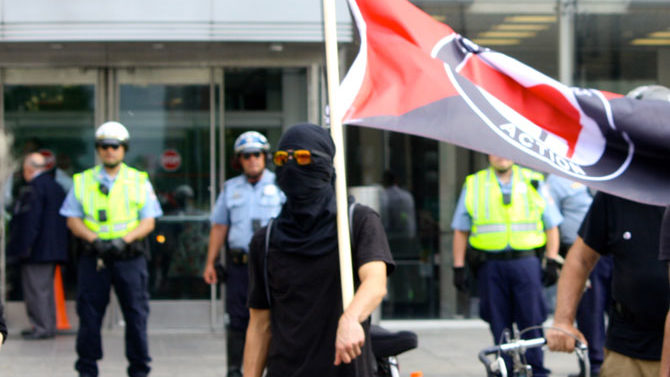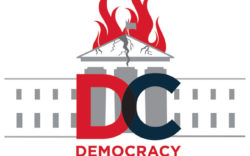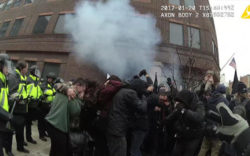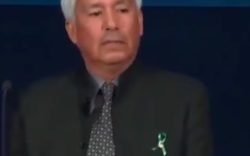A year ago, after the election of Donald Trump, Dylan Petrohilos hung an Antifa flag out in front of his house.
“I had [the flag] flying outside my home because Trump was elected, and there was a belief he was a fascist, and so we had this idea that we needed to bring back the moniker of anti-fascism,” Petrohilos told me at a bar where he was discussing the Washington, DC Riot Act case with other defendants arrested in connection with the protests of Trump’s inauguration.
When Petrohilos’ home was raided by D.C. police in April, the flag was the first thing they took. They also took seven small black flags, copies of The Nation and In These Times magazines and a banner, made during the financial crisis, that read “Kiss Capitalism Goodbye.”
These items are evidence in the J20 case, the first mass trial of which begins this week. Most of the defendants were arrested on Inauguration Day, after a protest (which the government has deemed a riot) resulted in several broken windows. Police officers threw more than 70 “non-lethal” grenades, sprayed dozens of canisters of pepper spray and cordoned off around 200 people in a “kettle” flanked by riot police and walls on all sides.
Though the Department of Justice claims Petrohilos conspired to plan the riot, he was not arrested that day. He says he was not even there. But the fact that he spoke about J20 on a podcast and was recorded by undercover police and the far-right sting video site Project Veritas at protest-planning meetings has put Petrohilos at the center of what could be the most important political conspiracy trial of a generation—one that could change the way we think about our data and other records of our actions.
Almost any statement made by Petrohilos about the day’s protest evidence was at play in what was to be the final hearing before this week’s trials. The Nov. 9 hearing was intended to establish the fact of the conspiracy, a move that would make co-conspirators’ statements admissible in court, despite hearsay rules.
Prosecutor Jennifer Kerkhoff cited statements made on the “It’s Going Down” podcast as evidence of conspiracy. At one point, the judge, Lynn Leibovitz, surmised that appearing on a podcast required planning, so if Petrohilos was going on the podcast to talk about the protests, perhaps the existence of the podcast could be evidence of conspiring.
“Saying that coming on a podcast recorded for public consumption to talk about a public demonstration is evidence of conspiracy is like saying that someone writing a column in High Times is proof that they are in a drug cartel,” Paul Hernandez, a member of the It’s Going Down editorial collective, wrote to me. “The state is trying to make the case that anyone that attends a demonstration or protest is thus involved in a conspiracy.”
Petrohilos is not among those to stand trial this week. The prosecution classed all of the defendants into four categories based on their alleged involvement in planning or participating in the riot. He is in Category Two, which Kerkhoff has referred to in court as the “planners.”
“Dylan Petrohilos said, ‘Come with me if you want to talk about black bloc. I am black bloc,’” Kerkhoff said in court, citing the planning meeting that was infiltrated.
“Black bloc” is the essence of a large part of the J20 charges. It is a political strategy in which wearing identical clothing and face masks allows a group to move collectively through the city in protest, mimicking the black flag of anarchism and making it harder for police to identify individuals, which is why the government is using clothing as evidence of conspiracy.
Isaac Dalto, Petrohilos’ friend, who is also included in Category Two as a planner, says the government is using affiliation with the Industrial Workers of the World union, for whom he organizes, as evidence of conspiracy. “Because they went to legitimate, above-ground union meetings about forming a union in their workplace, their Google calendars say IWW, and that’s being used against them to prove membership in this criminal conspiracy that we’re alleged to be part of,” says Dalto.
“Conspiring to commit lawful acts is not a crime. It’s not a conspiracy. It’s called organizing,” he said. “That’s the real danger of this case to democracy and dissent in this country—that any form of organizing or civil resistance stands to become a crime.”
The threshold for conspiracy is so low that two journalists, Aaron Cantú and Alexei Wood, are still facing charges for following a group that they were covering. Wood is part of the group that demanded a speedy trial and so goes to court this week.
With long hair, black clothes and a leather wide-brimmed hat, Wood may have looked a bit like an outlaw at the hearing, but he was arrested and charged with conspiring because he was livestreaming the political actions.
“The chilling effect is obvious,” he said. “It took me months to go document another protest. Even the most like, Grannies Against Trump thing, I didn’t want to go to. I was traumatized. Absolutely traumatized.”
Finally, he says, on May Day, he was fed up. “I was like, ‘Fuck it, this is what I do. This is my beat. This is what I’ve done for years,’” Wood said. “I didn’t do anything wrong. I live-streamed myself from beginning to end, and the entire world can decide whether I incited a riot… it’s out there for the whole world to decide, and I’m glad it is.”
Like what you just read? Support Flagpole by making a donation today. Every dollar you give helps fund our ongoing mission to provide Athens with quality, independent journalism.









